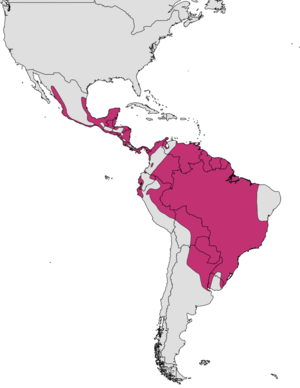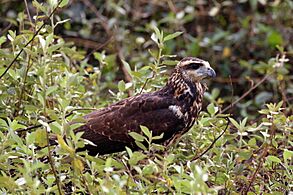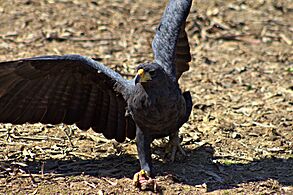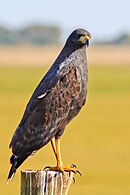Great black hawk facts for kids
Quick facts for kids Great black hawk |
|
|---|---|
 |
|
| Conservation status | |
| Scientific classification | |
| Genus: |
Buteogallus
|
| Species: |
urubitinga
|
| Subspecies | |
|
|
 |
|
The great black hawk (Buteogallus urubitinga) is a large bird of prey. It belongs to the Accipitridae family. This family also includes eagles, hawks, and Old World vultures. These powerful birds are known for their sharp eyesight and strong talons. Great black hawks live in warm, tropical areas of the Americas.
Contents
Understanding the Great Black Hawk's Name
Scientists give every animal a special two-part name. This helps everyone know exactly which animal they are talking about. The great black hawk's scientific name is Buteogallus urubitinga.
The word urubitinga comes from an old language called Tupi. It means "big black bird." This name perfectly describes this impressive raptor.
There are two main types, or subspecies, of the great black hawk:
- B. u. ridgwayi – Found from Mexico to western Panama.
- B. u. urubitinga – Found from eastern Panama to northern Argentina.
What Does a Great Black Hawk Look Like?
Adult great black hawks are about 56 to 64 centimeters (22 to 25 inches) long. They weigh around 1.1 kilograms (2.4 pounds). They look a bit like the common black hawk, but they are bigger. They also have a different call and tail pattern.
These hawks have very wide wings. Most of their body is black. Their short tail is white with a wide black tip. The hawk's beak is black, and its legs and a fleshy part above the beak (called the cere) are yellow.
Young great black hawks look a bit different. They are dark brown on top with spots and streaks. Their undersides are a light yellow-brown with dark spots. Their tail has several black and dark bars. The great black hawk makes a special piping sound, which sounds like ooo-wheeeeee.
Where Do Great Black Hawks Live?
The great black hawk lives in the tropical parts of the New World. This includes areas from Mexico through Central America to Peru, Tobago, and northern Argentina.
They mostly live near coastlines. However, they also make their homes in forests and open woodlands close to water.
Unusual Journeys of the Great Black Hawk
Sometimes, a great black hawk travels far from its usual home. One young hawk was seen in South Padre Island, Texas, in April 2018. Later that year, the same bird appeared in Biddeford, Maine. This was very unusual because Maine is much farther north than where these hawks normally live.
This hawk later moved to a park in Portland, Maine. It stayed there for some time. People were very interested in this traveling bird.
Reproduction and Life Cycle
Great black hawks build a large nest out of sticks in a tree. The female usually lays one egg. This egg is whitish with dark blotches.
What Do Great Black Hawks Eat?
The great black hawk is a skilled hunter. It mainly eats reptiles, like snakes and lizards. It also hunts other small animals. These include amphibians (like frogs), fish, other birds, and small mammals (even bats).
They also enjoy crabs, large insects, and sometimes eat dead animals (called carrion). They will also eat eggs and even some fruits. Great black hawks often hunt for food while walking on the ground. You might also see them soaring high above woodlands, looking for their next meal. Along rivers in the Amazon, they have been seen raiding nests of hoatzin birds to find eggs and chicks.
Images for kids





